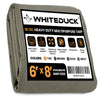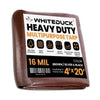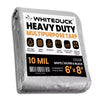Glamping vs. Camping: Which is Better for You?

Spending a weekend in the great outdoors is a fantastic way to reconnect with nature. How you approach your stay, however, might look different from how others do it. In the 21st century, there are a handful of ways to experience mother nature overnight. Choose from camping at a traditional family campground, pitching a tent in the backcountry, camping out of your vehicle, staying in an RV, or enjoying the luxuries of a prebuilt glamp site.
For the everyday nature lover, camping and glamping are going to be your most likely options. Both are accessible, immersive ways to vacation outdoors. But how are they different, and how do you know which one is right for you? Let’s dive in.
What Is Camping?
Camping is often used as an umbrella term to describe any overnight stay in the outdoors, meaning everything listed above is technically considered camping. Though, if we’re talking traditionally, camping is the basic act of erecting a tent to stay overnight in the wilderness. In the context of camping vs. glamping, camping involves minimal luxuries. This means the camper provides all of their own basics: shelter, gear, food, water, and other miscellaneous supplies.
The intensity of camping can vary, however. At a traditional, family-style campground, guests may be offered basic amenities like potable water and relief areas. Nicer facilities may even have communal showers. Other campsites will be bare bones, solely providing the land you’ll pitch your tent on. All of your other basic needs will require your own planning – and it’s often primitive! Both routes fall under the traditional camping umbrella, and what we’ll compare glamping to.
What Is Glamping?
Glamping, on the other hand, is a more elevated version of camping. Combine the words glamour and camping, and you get glamping! While the word didn’t appear in the Oxford English Dictionary until 2016, glamping can be traced back to the early 1900s when well-off individuals sought luxury experiences to connect with the outdoors. In the modern world, glamping provides the same luxurious experience that traditional camping often lacks. This usually entails more comforts like full-size beds and electricity. Glamp site offerings vary but may include anything from gourmet meals and running water to onsite spas and hot tubs. The main idea is that instead of fending for yourself like you would while camping, many everyday comforts are built into the experience. With broad definitions out of the way, let’s dig a little deeper into what really separates glamping from camping.
The Key Differences Between Camping and Glamping
The primary differences between camping and glamping are in the shelter you stay in, the amenities and experiences available to you, and the cost.
The shelter
When opting for a traditional camping experience, you’ll be required to bring and pitch your own shelter. The size, style, and material of your tent are entirely your decision. If you’re solo camping, you might go for a small cabin style tent. If you’re bringing your family or a group of friends, large canvas tent camping may be the way to go. Your setup inside the tent will be another decision up to your discretion. Whether you want to go minimal and bring only the essentials, or if you want to maximize comfort with extra gear like sleeping cots, is your call.
The main factor to consider is that these decisions, and the setup they require, will be up to you and your crew to execute. This tends to result in a less luxurious and more primitive experience in the outdoors.
As for glamping, you’ll enjoy the maximum comfort available – without the hard work. Most glamping experiences involve pre-built shelters and require no setup from guests. You could, of course, create your own glamping setup from scratch, but that’s another story entirely. Luxury glamping tents are the standard shelter and provide unmatched comfort in the outdoors. These shelters can take many shapes and sizes, but they’re often large, wall-style tents that resemble permanent structures with their vertical walls. Wall tents boast more room for activities within the tent and ample space to relax at the end of an adventurous day. Wall tents with stove jacks are an added luxury, with a tent stove that provides you warmth during cold seasons and the ability to cook your meals right inside your tent.
Besides the shelter itself, glamping experiences often offer added comforts like in-tent furniture, extra linens and blankets, and even electricity for temperature control and lighting. These luxuries inevitably make your shelter feel more homey than a traditional camping shelter.
The amenities & experiences
As discussed at the beginning of this article, the amenities and experiences you’ll enjoy will differ between camping and glamping. Camping amenities will be minimal, usually not exceeding basic necessities. Primitive campsites will offer little more than the land to pitch your camp on. More traditional campgrounds may have basics available, like potable water stations, restrooms, and communal showers. Some family-style campgrounds may offer onsite activities at an additional cost, like kayaking tours or fishing gear rentals. Other than that, you’ll be left to your own devices at camp to figure out the rest.
The amenities and experiences at a glamp site will depend on the glamping experience you purchase, but you should expect more than you’d get when simply camping. In addition to running water and fully-equipped restrooms, you’ll likely have access to amenities that go beyond the basics. This could include anything from electricity and WIFI to onsite saunas and hot tubs. Experiences offered at a glamping site range too, but it’s not uncommon to see luxury services like spa packages and gourmet meal plans. Since you’re intentionally spending your vacation outdoors, typical outdoor offerings like water activities and rentals are common, too.
The cost
With all of the added comforts, amenities, and experiences, it’s no surprise that glamping is the more expensive of the two. A campsite in a traditional campground can cost you anywhere from $15 to $100 per night, on average in the United States. Actual prices will fluctuate, with the most basic of sites being cheaper and the more amenity-rich campgrounds more expensive.
Glamping experiences, on the other hand, can run you anywhere from $150 to $1000 per night. Expect prices on the higher end when you travel to in-demand locations or book glamping sites that offer extended services and amenities. Even though you’re in the outdoors, you’re hardly roughing it when you opt to glamp. Combine this with the uniqueness of the glamping experience and it’s no wonder why glamping rivals any other luxury vacation when it comes to price.
Picking the Right Experience for You
You’re now an expert on the differences between glamping and camping, but how do you know which one is right for you? Consider these 4 factors when picking your outdoor adventure:
Your personal preferences
What this choice really comes down to is your personal preferences. Ask yourself: do I enjoy a humble experience or do I prefer luxury? If your idea of reconnecting with the outdoors involves roughing it and truly “being one with nature,” camping might be better for you. If the idea of sleeping alongside the critters of the forest on the cold hard ground gives you the shivers, glamping may be the better fit. You know yourself better than anyone, so listen to your heart on this one.
How much work you’re willing to do
As we discovered throughout this article, camping is a much more intensive, hands-on experience. If you take pride in setting up a great campsite and genuinely enjoy the fruits of your labor, camping is the way to go. If, however, you’d rather pull up to a pre-built site that requires minimal effort on your part, glamping is for you. It’s also worth considering your years of experience and skill set. While everyone can learn the skills needed to set up camp, glamping may be a more accessible introduction to the outdoors for first-timers.
What you can afford
The luxuries associated with glamping come at a price, so part of your decision will inevitably lie in what you can afford. One reason camping is such a popular choice among travelers is how cheap it can be. With campsites costing as little as $15 in some areas, the low price may be the only draw you need. For others, the experience of glamping will be well worth the steep nightly price.
The level of disconnection you seek
It’s much more likely that your glamp site will offer WIFI or have access to cell service than it is for you to be connected at your campsite. If your true goal is to take a digital detox and disconnect from your devices during your stay outdoors, camping is the way to go. If you’re more keen to document every moment of your trip on social media, glamping may suit you more.
At the end of the day, your personal preferences as an adventurer will dominate your choice. The good news is, you can’t go wrong! Both camping and glamping are incredible ways to get outdoors and connect with the wilderness. The beauty of camping is the ability to make your experience your own, while glamping services are sure to provide you with everything you need to have a memorable trip.















